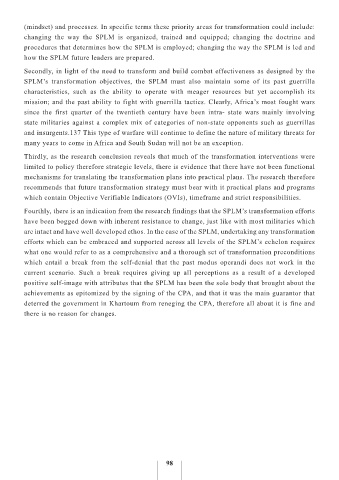Page 104 - EVOLUTION OF THE SUDAN PEOPLE’S LIBERATION MOVEMENT(SPLM),
P. 104
(mindset) and processes. In specific terms these priority areas for transformation could include:
changing the way the SPLM is organized, trained and equipped; changing the doctrine and
procedures that determines how the SPLM is employed; changing the way the SPLM is led and
how the SPLM future leaders are prepared.
Secondly, in light of the need to transform and build combat effectiveness as designed by the
SPLM’s transformation objectives, the SPLM must also maintain some of its past guerrilla
characteristics, such as the ability to operate with meager resources but yet accomplish its
mission; and the past ability to fight with guerrilla tactics. Clearly, Africa’s most fought wars
since the first quarter of the twentieth century have been intra- state wars mainly involving
state militaries against a complex mix of categories of non-state opponents such as guerrillas
and insurgents.137 This type of warfare will continue to define the nature of military threats for
many years to come in Africa and South Sudan will not be an exception.
Thirdly, as the research conclusion reveals that much of the transformation interventions were
limited to policy therefore strategic levels, there is evidence that there have not been functional
mechanisms for translating the transformation plans into practical plans. The research therefore
recommends that future transformation strategy must bear with it practical plans and programs
which contain Objective Verifiable Indicators (OVIs), timeframe and strict responsibilities.
Fourthly, there is an indication from the research findings that the SPLM’s transformation efforts
have been bogged down with inherent resistance to change, just like with most militaries which
are intact and have well developed ethos. In the case of the SPLM, undertaking any transformation
efforts which can be embraced and supported across all levels of the SPLM’s echelon requires
what one would refer to as a comprehensive and a thorough set of transformation preconditions
which entail a break from the self-denial that the past modus operandi does not work in the
current scenario. Such a break requires giving up all perceptions as a result of a developed
positive self-image with attributes that the SPLM has been the sole body that brought about the
achievements as epitomized by the signing of the CPA, and that it was the main guarantor that
deterred the government in Khartoum from reneging the CPA, therefore all about it is fine and
there is no reason for changes.
98

